#odin & runes
Text

The Futhark Rising
By: LuciferArcadia [DeviantArt]
Source
Posted: 2020/07/27
#LuciferArcadia#LuciferArcadia DeviantArt#the futhark rising#artists on DeviantArt#odin#odin runes#norse shamanism#norse shaman#rune discovery#runes#futhark#futhark runes#norse runes#elder futhark#elder futhark runes#rune#norse paganism#odinn#odin art#odin runes art
7 notes
·
View notes
Text
I'm looking for blogs to follow. I know I already made a post like this, but it's been a while, my dash is fairly dead, and theres so many gross bigots its hard to find good blogs. Please like/reblog post about any of the following:***
Heathenry
Norse polytheism/norse paganism
Especially Freyr, Odin, Njord, Ran, Loki, and/or Skadi
Norse mythology
Sea witchcraft
Techno witchcraft
Sigil witchcraft
Hedge witchcraft
Kitchen witchcraft
Hearth witchcraft
Spiritwork
Working with the fae
Hellenic polytheism
Greek mythology
Tarot
Runes
***NO BIGOTS***
#heathenry#norse paganism#norse mythology#norse polytheism#freyr#njord#odin#skadi#loki#ran#hellenic polytheism#greek mythology#sea witchcraft#techno witchcraft#tarot#runes#hearth witchcraft#kitchen witchcraft#hedge witchcraft#sigil witchcraft#spiritwork#working with spirits#working with fae#looking for blogs to follow
480 notes
·
View notes
Text
ᚼᚢᛆᚱᛋ ᚦᚢ ᛒᚰᛚ ᚴᛆᚿᚿᛐ
ᚴᚢᛂᚧ ᚦᚢ ᚦᛂᚱ ᛒᚰᛚᚢᛁ ᛆᛐ
ᚮᚴ ᚵᛂᚠᛆᛐ ᚦᛁᚿᚢᛘ ᚠᛁᛆᚿᛑᚢᛘ ᚠᚱᛁᚧ
Hvars þú bǫl kannt,
kveð þú þér bǫlvi at
ok gefat þínum fjándum frið.
When you recognize evil,
say it is evil
and give your enemies no peace.
Hávamál 127
126 notes
·
View notes
Photo


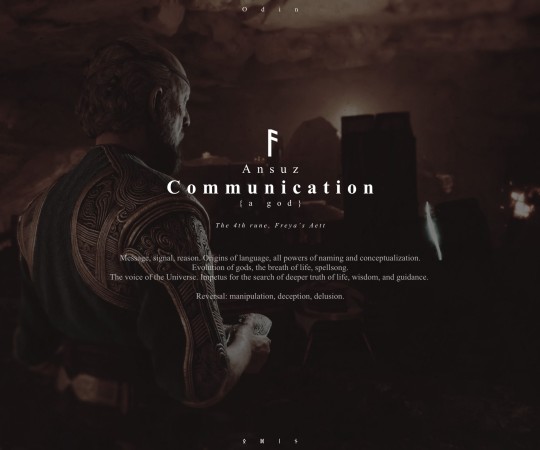





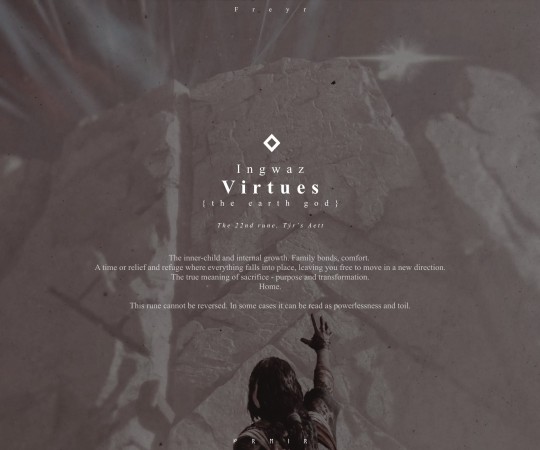
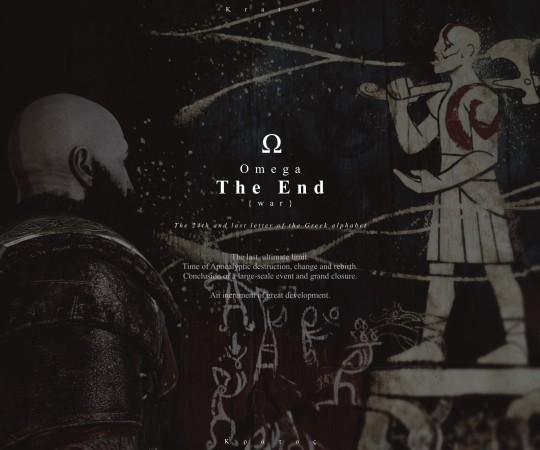
runes representative of deities + meaning
#that incident with the kenaz rune on draupnir made me want to look into more runes#it did not disappoint#god of war#god of war ragnarok#freya#thor#odin#atreus#loki#heimdall#the norns#baldur#tyr#freyr#kratos#it’s very satisfying to me that all the groups turned out to have 1 less member than the last one#and it’s like 4 for freya’s aett#3 for heimdall’s#2 for tyr’s#and just kratos#you have no idea how many times i changed that atreus still#i also really like that freya is 'new beginnings' and kratos is 'the end' :)
1K notes
·
View notes
Text

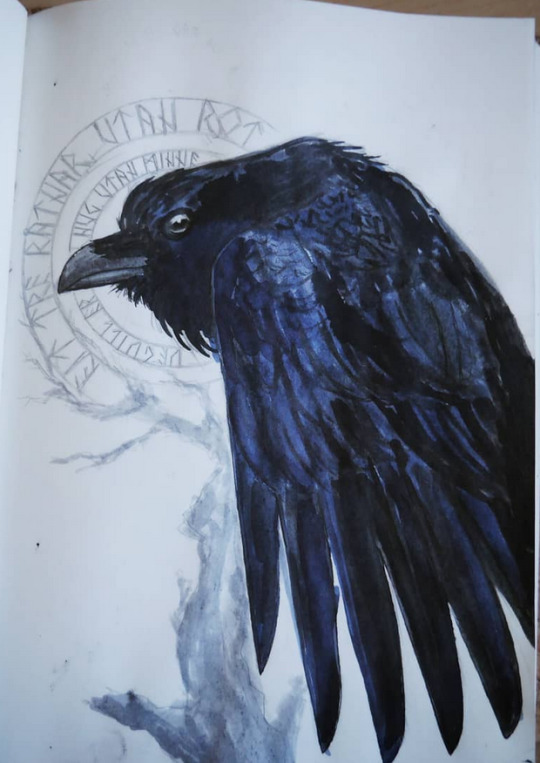
MUNIN
Å minnefuggel
Vær hos meg all mi tid
Wardruna’s album Kvitravn was very inspirational to draw some things when it came out. Made in 2021
#munin#huginnandmuninn#hugin#odin#norsemythology#wardruna#kvitravn#viking#vikings#pagan#heathen#norse#vikingart#raven#runes#muninn#huginn#drawing#painting#ink#myart
107 notes
·
View notes
Text

was working on a logo today and looked at previous vector designs i did and realized i never posted this one on here :^)
#odin#alldad#norse gods#norse mythology#sleipnir#huginn and muninn#the runes say odin's little bitch btw#its me#im odins little bitch
62 notes
·
View notes
Text
The actual meaning of Runes

When dealing with runes, their name should be analyzed first. The alphabet is called “Futhark” based on the beginning letter of the first six runes’ names.
“Runes” aren’t a singularity. There’s the Elder Futhark and the Younger Futhark, also called Futhork. Than there’s also regional varieties such as the Nordic runes, Frisian runes, Anglo-Saxon runes and varieties due to changes through time. Something that looks like a rune but isn’t is called a “tectiform”.
Etymological there are plenty of Germanic varieties of the word. Rún is Old Norse/Nordic, Old Saxon rūna, Middle Dutch’s rune or ruin and rúna in Gothic. In Finnish runo means “poem”.
The word “rune” in essence means “secret” but is also a word used for “confidential conversation/writing”, “concealment” but also “counseling”.
The meaning of the word was held literally. It was not meant for basic administration, conversation or education. Few people actually knew how to read or write runes. It was reserved for a select but also elite part of society.
This brings us to Odin. The tales tell how he hung himself from the branches of Yggdrasil for nine days to gain the knowledge of runic wisdom. This makes him the god of the hanged (Hangagud), god of runes (Rúnatyr), father of magical songs (Fadir Galdrs) and wise one (Svidur). Knowing runes was viewed as knowing (some of) Odin’s magic and/or power.
Runes were used for “runic magic” a not very specified kind of magic in the Eddic texts. Individual runes were given names, such as the first rune, Fehu which means cattle or wealth. Naming individual characters is a common historic practice. These are not to be taken literally, but often are in modern esotericism and fantasy. Germanic Runic spells however are a weird thing. There are mystical inscriptions on the back of brooches, stones, wooden artifacts, etc. We know what they say, but not what they mean.
Mostly runes aren’t actually that far fetched. They are found on grave/memorial stones or a craftsman’s signature on an object. An example of this is the Nolby stone; “Bergsven and Sigfust and Fride raised this stone in memory of Bure, their father. Fartägn carved this stone”.
#frankish#merovingian#viking archaeology#archaeology#carolingian#charlemagne#field archaeology#viking mythology#merovingian archaeology#germanic mythology#norse runes#rune magic#norse mythology#anglo saxon#field archaeologist#frisian#odin#viking#vikings#germanic#germanic folklore#germanic archaeology#wodan#anglo saxon archaeology#history#jewelry#norse#poetic edda#proza Edda#rune stone
115 notes
·
View notes
Text
Runes have been made into far-right symbols. Othila, Algiz, and Sowilo have been especially twisted, but the evil of Hitler and his ideological spawn have touched all of them.
It makes me sad.
It makes me sad that some runes are banned in places like Germany. It makes me even sadder that it was correct to ban them.
It makes me sad that some people feel afraid when they see runes. It makes me even sadder that that fear is justified.
However, all is not lost.
Runes are still fundamentally good. They may have to be hidden for the time being because of how they’ve been abused, but they can still be used for good.
All is not lost.
Othila, Algiz, Sowilo, and all the other runes are still good. They continue to be used for evil, but that does not make them evil. Runes will never be lost to evil unless we let them be.
All is not lost.
As long as Odin is the all-father, all is not lost.
As long as Thor is the protector of all humanity, all is not lost.
As long as Heimdall stands guard, all is not lost.
As long as Freyja bears the feathered cloak, all is not lost.
As long as we stand against fascism, all is not lost.
#pagan#paganism#rune magic#norse paganism#norse gods#thor#freyja#Odin#heimdall#eclectic pagan#futhark runes#political
98 notes
·
View notes
Text
My mother got me a St. Michael (the archangel) medallion. But little does she know that I'm going to make it protective with Norse magick. Checkmate bc witchcraft is creative, no matter the image you are intending to be a vessel.
#norse paganism#odin#elder futhark#rune reader#rune divination#rune druid#closet witch#closet witchcraft#witchcraft#witches#pagan witch#norse witch
59 notes
·
View notes
Text
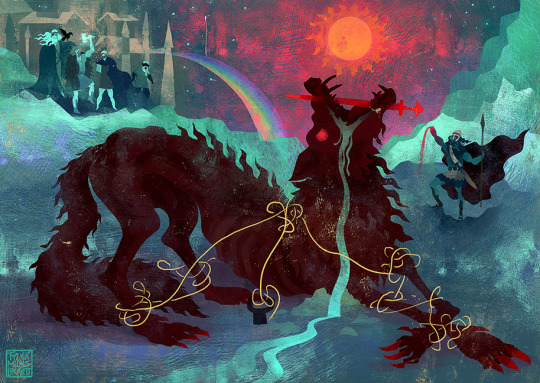
Binding of Fenrir, along with many other prints starting from 25$ on my etsy shop:
#norse#viking#vikings#pagan#odin#norsemythology#valhalla#heathen#thor#nordic#runes#norsepagan#asatru#vikingstyle#ragnar#paganism#warrior#godofwar#celtic#norsegods#shieldmaiden#vikinglife#beard#lagertha#ragnarlothbrok#history#vikingwarrior#rune
115 notes
·
View notes
Text

Hangman Odin
#art#illustration#drawing#pen drawing#artists on tumblr#portrait#ink drawing#ink illustration#draw#artwork#odin#norse mythology#norse gods#ravens#spear#norse pantheon#runes#mythology#fantasy art
139 notes
·
View notes
Text

Rune Garden
Hávamál, Rúnatal
138. Veit ek at ek hekk vindga meiði á
nætr allar níu,
geiri undaðr ok gefinn Óðni,
sjálfr sjálfum mér,
á þeim meiði er mangi veit
hvers hann af rótum renn.
I know that I hung on a windy tree
for all of nine nights,
wounded by a spear and given to Odin,
myself to myself,
on that tree of which no one knows
the kind of roots it runs from.
139. Við hleifi mik sældu né við hornigi,
nýsta ek niðr, nam ek upp rúnar,
œpandi nam; fell ek aptr þaðan.
They blessed me with neither bread nor horn,
I peered down, I took up runes,
screaming I took them; I fell back from there.
#runes#runic#old norse#norse#calligraphy#book art#odin#heathen#pagan#norse paganism#norse polytheism
140 notes
·
View notes
Text
Name of Odin attested 150 years earlier than previously thought!
A really cool discovery made by Danish runic and language history researchers from a huge gold treasure which turns out to be the oldest attested mention of the god Odin not only in Scandinavia but in the world.
Two Danish articles that I translated below, but tl;dr summary:
A historical discovery made my Danish archeologist, runic researchers and language history researchers reveals that there's attestations of the old norse god Odin by name about 150 years earlier than previously thought (not just in Scandinavia, in the world). The translation of a runic inscription on a bracteate contains the phrase "he is Odin's man", and the bracteate is dated to the 5th century. This means that at least in Denmark, there is an attested belief in Odin (and most likely the other old norse deities) much earlier than previously thought, but it is generally the oldest attestations to the named deity "Wōd[a]nas" (Odin) thus far discovered (previously oldest attestation was from southern Germany and the 6th century. In Denmark the oldest previous attestation was 8th century bone amulet). The discovery has also opened up new ways of translating runic inscriptions this old, which could help with further research of older texts that have previously been untranslatable.
EDIT: Also English article https://abcnews.go.com/Technology/wireStory/oldest-reference-norse-god-odin-found-denmark-treasure-97704339
Translation and Danish articles below, which also has images.
https://www.dr.dk/nyheder/indland/guldfund-afsloerer-danskerne-troede-paa-odin-thor-og-loke-langt-tidligere-end-foerst?fbclid=IwAR0x2RkzqvGCVn87f_W5gBMcp9B8jbCWEiXV-JX2j4ZmOvRh_1XEWJ9hOkU
Gold find reveals: The Danes believed in Odin, Thor and Loki much earlier than first thought
Runes on a huge gold treasure from Jelling show that Odin is mentioned 150 years earlier than has been seen before. The discovery shakes the whole of Norse mythology.
When the two amateur archeologists Jørgen Antonsen and Ole Schytz made the spectacular gold find in a field near Jelling almost two years ago, they also greatly shook our knowledge of Norse mythology. It turns out that one of the gold pieces contains the world's first attestation by name of the Norse god Odin. The so-called Vindelev treasure was previously described as the most spectacular runic find since the golden horns. But the name of the god gives this one an extra edge: - It is the first time in world history that Odin's name is mentioned, and it takes Nordic mythology all the way back to the beginning of the 5th century. That makes the Vindelev find even more spectacular, says script researcher Lisbeth Imer from the National Museum. According to the researchers, this means that the gods we know from Norse mythology were already known at the beginning of the 4th century, which is 150 years earlier than previously proven.
The discovery was made after the researchers spent quite some time trying to decipher the runes and carvings on the 22 gold objects with a weight of around 800 grams, so-called bracteate. On one of the bracteates the sentence 'He is Odin's man' is included and refers to the bracteate's portrait of an unknown king or “great man”. And it is this sentence that shows that the belief in the Nordic gods was real, earlier than people have believed until now. However, deciphering exactly what the runes actually meant has not been an easy task.
“The runic inscription has been the most difficult to interpret in my 20 years as a runologist at the National Museum, but the discovery is also absolutely fantastic,” explains Lisbeth Imer.
According to the researchers, the discoveries are important because they contribute to Danish history being rewritten.
“I have not seen such well-executed runes and such a long text on a Danish find from this period since the golden horns,” says Lisbeth Imer. “It could become a key to understanding other prehistoric runic inscriptions that we have not been able to read so far.
Krister Vasshus, who specializes in ancient language history in Scandinavia, is also pleased with the new finds. “We have found the proof in black and white, and it is a huge discovery. I can't put my arms down in pure ecstasy,” he says. According to the researcher, it is very rare that researchers even get the opportunity to examine similar material. “This type of inscription is extremely rare, we find one perhaps every 50 years, and this time it has turned out to be world history,” explains Krister Vasshus.
The Brakteaten is currently on display at the National Museum.
https://videnskab.dk/forskerzonen/kultur-samfund/verdens-aeldste-odin-fundet-i-vindelev?fbclid=IwAR366iLS8MWtkeWTrrqlIbMxygGlZ-tAWG9FJXFsqDRIabHh3o5LgMphBzo
The world's oldest Odin found in Vindelev
Ancient gold medallions found by amateur archaeologists turn out to be the oldest examples of the god Odin's name in the entire world.
In December 2020, two old friends and amateur archaeologists go for a walk with a detector in a field in Jelling. Little did they know that with the findings from this trip they were writing the history of Denmark - and gave us the most difficult task we have ever faced as runologists and language experts respectively. The Vindelev treasure, as the find has been called, with its 800 grams of real gold, is one of the largest gold treasures found here in recent times. It fascinates not only because of the red ancient gold, but also because of the bracteates - i.e. gold medallions - with runes found in the treasure. They write the history of Denmark.
100 years older than the earliest find so far
Two of the bracteates have some very long inscriptions in which the name of the supreme god of the Æsir, Odin, appears. The bracteates are dated to the fifth century and are thus the oldest examples of the god Odin's name in the whole world - at least for now. The oldest inscription previously in which the god Odin appears is from the southern German area. At a large burial ground near Nordendorf, the god's name was found scratched on the back of a suit buckle dating to the second half of the 6th century. In Denmark, we have to go back to the first half of the 8th century, i.e. on the threshold of the Viking Age, before we have Odin's name represented on a piece of a human skull from Ribe. Here, Odin is invoked as one of three gods who will help the owner of the amulet from illness. Odin's name is a well-known runic inscription from all over the world and is found, among other things, in a number of continental and Old English written sources, for example 'Origin of the Langobards', 'Sächsisches Taufgelöbnis' (the Old Saxon baptismal vow) and 'Nigon Wyrta Galdor' (The formula of the nine herbs). In this article, we will talk about why the Vindelev treasure is completely unique, and why the runic inscriptions on the old bracteaters have been one of the most difficult tasks for us.
Gold pendants
Excavations carried out by the Vejlemuseerne showed that in the area where the treasure was found, there had been a farm consisting of several longhouses and fences. The treasure therefore presumably belonged to the local magnate or king, who buried it inside the house or near the house. In the 5th and 6th centuries, rich magnates or minor kings used gold pendants to show off their status and wealth. The motif on these pendants, called bracteate, was inspired by the Roman imperial medallions. Many bracteates show a male person seen in profile, possibly in the company of a four-legged animal, which is probably a horse.
Is it Odin?
For many years, researchers have debated whether the people depicted on the bracteates are the god Odin, or whether they are kings, princes or magnates. The runic inscriptions on the Vindelev bracteates mostly indicate the latter. Perhaps bracteates were given away to important alliances. Saxo Grammaticus writes about the legendary king Frode that he had a gold necklace that could be used as a reward. This chain was composed of different links, which alternated with images of kings. Such chains with bracteates have been found in several places in Denmark.
Long runic inscription with the name Odin
One of the bracteates from Vindelev is very special and very valuable for research. It has a long runic inscription which is particularly well-formed and which makes linguistic sense. The inscription runs in a circle around the motif of the bracteate, which shows the face of a king seen in profile and with a nice hairstyle. In front of the face is a swastika and a semicircle - perhaps symbolizing the sun and the moon. Below the face stands a four-legged animal, probably a horse, with a marked harness and something sticking out of its mouth. The horse's ear points towards the king's open mouth.
Erased and written out in one go
Although the runes are very well formed and immediately easy to read, we have problems understanding the text. This is due, firstly, to the fact that the bracteate is very worn, so that the runes in important places are almost completely gone. Secondly, the inscription is written out in one go. That is, there is no pause between words, nor are there any signs showing where one word ends and the next begins. In addition, the language on the bracteate is more than 1,500 years old.
On the trail of a hunter
The first part of the text of the bracteate is particularly difficult, because there are partly words we do not know from other sources, partly words which do not seem to fit with the developments in the history of the language. The inscription possibly begins with the word hostiōz, which can mean 'sacrificial animal' (in the plural). In that case, it is a Latin loanword, which would mean that the word hostia was borrowed from Latin and embedded in the Old Norse language. In the long sequence that follows, there is probably a declaration that someone is helping a hunt or a hunter. We may also encounter a personal or nickname Jaga, which may even have been perceived as a pun on the verb 'to hunt' (“at jage”).
A king's locket?
We are most certain of the last part of the inscription. It says iz Wōd[a]nas weraz, which can be translated as 'he is Odin's man'. But who is this man of Odin? It must be the hunter who may have had the (nick)name Jaga. And who is the hunter or Jaga? We know that Saxo calls the images on bracteates kings, and we know that the bracteates imitate Roman emperor depictions. We must therefore interpret the inscription as a presentation of the depicted person, who is the king. The king is referred to as Odin's man, which points to his divine legitimacy, and perhaps also tells us that he is the supreme cult leader of that society.
Another Odin inscription in Vindelev
The long inscription appears to have been copied on one of the other bracteates, but in a much more poorly executed reproduction. This bracteate also shows a king seen from the side with a nice hairstyle above a horse with its ear pointing towards the king's mouth. In front of the face are the same symbols as on the first bracteate and in addition three dots which perhaps symbolize the stars. The inscription runs in a circle around the motif, and some of the characters are clearly runes, while others just look like or are blurred long lines. It seems that whoever made the inscription in the matrix did not fully understand the text, but copied the appearance of the characters as best they could.
Is there perhaps a holy text with the same meaning?
The meaning of the inscription has clearly been the same as on the first bracteate, but there is a detail which means that it cannot be interpreted as a direct copy of the first: the name Odin is spelled in a different way, and also it appears that the scribe has exchanged two runes. Where he actually wanted to write woþanas, he has written þowa(nas). The two runes, which represent the sounds /w/ and /þ/, are almost identical, which makes them easy to confuse - especially when the runes are only 2mm high. This means that there once existed a third inscription with the same content as on the two bracteate. It must have been a very important and perhaps sacred text that many have been interested in copying. There could be many good reasons for being filled by Odin's power and magical abilities as a king.
The solution to an old riddle
The long and complete inscription on the bracteate from Vindelev is the key to a number of unsolved riddles in the Iron Age. It shows that Odin is a very old deity, who was already known in the 5th century, and that the images of the bracteates should rather be interpreted as kings than as the god himself. And so it is the key to understanding how illegible bracteate inscriptions originally made sense.
A funny detail is also that the bracteate with the poorly executed text from Vindelev has a stamp-identical twin from Bolbro on the outskirts of Odense, made with the same pattern. The Bolbro bracteate was found in 1852 and has since then been in the National Museum's collections. There has thus been an ancient Odin inscription in the National Museum's exhibitions for the past 170 years - but no one knew that until the Vindelev treasure was found. Lisbeth M. Imer and Krister S. K. Vasshus will publish a scientific article about the runic bracteates from Vindelev in the international journal NOWELE (North-Western European Language Evolution), which will be published in April-May 2023. The Vindelev treasure can be seen in the National Museum's Danish exhibition 'The Hunt of Danish history' for the rest of 2023. The Bolbro bracteate is part of the permanent exhibition at the National Museum.
#odin*#odin#heathenry#norse mythology#forn sed#runes#archeology#asatru#danish history#old norse history
190 notes
·
View notes
Text
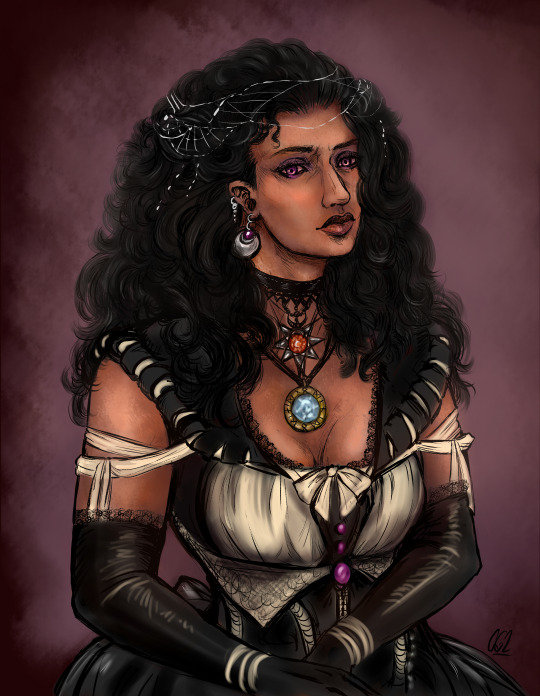
Yennefer of Vengerberg, portrait in Nimue's tower.
Anyone else imagine Yen's hair to be huge with small curls?
#the witcher#yennefer of vengerberg#the witcher book#wiedźmin#lady of the lake#the blue gem is the brisingamen#it has futhark runes that say odin on it#yes I imagine pretty much anyone in the witcher to be camp#it's serious and camp at the same time and i love it#my art
76 notes
·
View notes
Text

174 notes
·
View notes
Text
I love Elden Ring lore, because it's like George R. R. Martin wrote a world heavily steeped in Norse Mythology, and then Miyazaki went to read a book about Norse Mythology, got to the part where it said the gods knew they were going to die, but accepted it because it was ~fate~ and their ~noble obligation~ and ~necessary~. That upon their deaths, and after the Ragnarok, the world would be born fresh and lush and new and just...
Miyazaki: [looks at Norse Mythology]
Miyazaki: [looks at Dark Souls]
Miyazaki: [looks at Norse Mythology]
Miyazaki: [looks at Dark Souls]
Miyazaki: Pff, yeah right, like they'd ever just give up THAT easily.
#elden ring#How to subvert Ragnarok:#Step one: Kill the fire jotunn so Muspelheim is no longer a threat#Oops can't actually kill Surtr uhhhh let's just curse him#good enough.jpg#Step two: Banish the einherjar and redefine what a valkyrie is#Except we'll keep them in the wings in case they need to show up 15 minutes late with Starbucks to fix things#Step three: Give Fenrir the rune of death#No trust me guys this makes sense!!!!#Because he'll be banished and cursed!!!#Step 4: Ensure that - oh shit Baldr was killed anyway#And it was by Hodr?? On purpose????#Uh oh#At least Freyr still has his blade- aaaaaand he let it out of his sight#And someone just fed themselves to Jormungandr on purpose#That better not have been Thor!!!!#Hraesvelgr is dead and we banished his warriors!#No Naglfar for us!#What do you mean the Naglfar is gone#What do you mean Odin is missing#What do you mean Loki is missing#What do you mean Heimdall took over the capital#At least Garm is mysteriously missing so he can't kill Tyr!#What do you mean Freyja just nuked Tyr in the face and drove him insane
17 notes
·
View notes